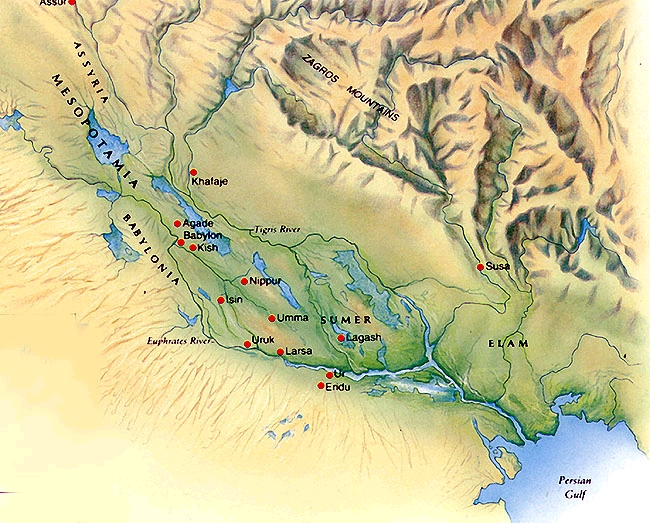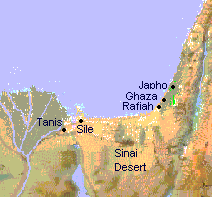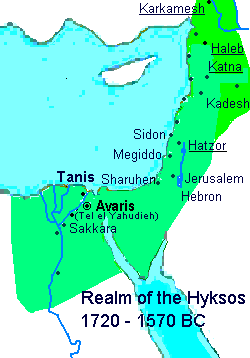 |
An Incomplete History
Origins of the Earliest Scripture and the Story of the Patriarchs, Abraham,
Issac, and Jacob (Israel)
Prehistory to 1850 B.C.E.
Hebrews do not appear in the historical record until between 1220 B.C.E. during the reign of the Egyptian king Marniptah. The granite inscribed account of Marniptah's military campaign in Asia lists Israelites as one of the conquered peoples and says that they had moved to "Canaan." Genesis 12-50 provides the only other historical account of the Hebrews, wherein they trace their origins back to a single man, Abraham, from Mesopotamia. The pre-Egyptian Hebrew history is called "the age of the patriarchs ." It is virtually impossible to date this age. The Hebrew history of the times was written down over a thousand years later, and no other peoples had an interest in the Hebrews. Historians estimate that the account is of the times between roughly 1950 and 1500 B.C.E.
The area where historians believe the Hebrews lived, Mesopotamia, is one of the earliest cradles of civilization. "Mesopotamia" is Greek for "between the rivers." Mesopotamia lies between the Tigris and Euphrates rivers which flow through modern Iraq and (the Euphrates) Syria. Mesopotamia is made up of two different geographical regions. Northern Mesopotamia consists of fertile hills and plains carved by streams and rivers feed by seasonal rains. It supported farming, provided timber, and the mining of metals and stone. Southern Mesopotamia consists of plains punctuated by marshy areas. Farming was limited along the banks of the rivers and trade was important.
One must resist the urge to consider Mesopotamia as a single, coherent culture. Instead, Mesopotamia hosted diverse cultures, even during great empires like the Sumerians (a mysterious group of people, speaking a language unrelated to any other human language, who began to live in cities, which were ruled by some sort of monarch, and began to write) and the Akkadians (a Semitic people living on the Arabic peninsula during the great flourishing period of the Sumerian city-states around 2340-2125 B.C.E.). Mesopotamia consisted of largely independent city-states, each having their own cults, languages, kings, and administrations.
In this land, religious myths regarding creation and the powers and workings of nature abound. In fact, the oldest complete literary work, The Epic of Gilgamesh, comes from Ancient Sumeria, written on 12 clay tablets in cunieform script. The Epic recounts the adventures of the historical King of Uruk (somewhere between 2750 and 2500 BCE). The Epic's heroic mythology that incorporates many of the religious myths of Mesopotamia.
 |
The authors of Genesis incorporate many of the stories in The Epic of Gilgamesh into the books of Genesis.
For instance, the creation of man in a plentiful garden, evil's introduction
into a naive world, and a great, worldwide flood brought caused by the wickedness of
man.
The Hebrew history of the patriarchs indicates that Yahweh selects Abraham and his descendants as his chosen people. Abraham, a Semite living in the nothern Mesopotamian city of Haran is the son of Terah, who comes from the city Ur in southern Mesopotamia. Yahweh visits Abraham around 1950 B.C.E., telling him to leave Haran around 1950 B.C.E.. At that time the Mesopotamian region heading into chaos. Abraham travels west to Shechem, where Yahweh visits again, giving the land to him and his descendents.
The early Hebrews were nomadic tribal groups whose society structure their society around around a rigid kinship hierarchy. Their relationship with God is also a kinship relationship: anybody outside the kinship structure (anybody who isn't a descendant of Abraham) is not included in the special relationship with God. Atop the kinship hierarchy is the tribal leader, or "patriarch," meaning "father-ruler."
The early Hebrews, it is generally believed, did not practice a religion having to do with the Yahweh cult. Moses, the Hebrew history says, is the first to hear the name of God, Yahweh. Hebraic accounts of the patriarchs refer to "Elohim" (God), "El Shaddai" (God Almighty), and other variants. Though controversial, it is thought that several of the religious practices described in Genesis indicate a belief in animistic forces , possibly, even polytheism.
At the end of the patriarchal age, several tribes claim a common ancestor and a common identity, though their name is not known. The term Hebrew likely comes from the Egyptian word, "apiru," or "foreigner."
One problem with the Hebrew history is the dearth of good archaeological evidence to support the Abraham story, and the richness of contradicting archaeological evidence. As Gary Greenburg notes, "while it used to be almost universally taken for granted that the Patriarchs and the sons of Israel where historical figures and that Genesis mixed some basic historical truths with a variety of legends, a growing segment of the scholarly community accepts that the patriarchal stories may have no historical core at all." (Greenburg p. 112) Among the problems with the stories are the following:
Abraham could not have visited the city of Ur when it was the land of the Chaldees since the Chaldeans did not control the area until about the 8th century B.C.E.. Additionally, the passage was mistranslated for the King James version of the Bible from the Greek translation of the Bible. The actual language of the passage as well as other textual and historical considerations suggest that the stories were not written until about the 5th century B.C.E.. Most academics date the writing of the texts between the 10th and 6th century B.C.E.. The southern highlands of Palestine (from Jerusalem south the the Valley of Beersheba), where Abraham supposedly settled, is very sparse in archaeological evidence from this period, indicating only a few hundred nomadic pastoralists. Moreover, the Phillistines never entered the region until the 12th century B.C.E.. The "city of Gerar" in which Abraham's son Isaac encounters Abimelech, the "king of the Phillistines" (Genesis 26:1) was a tiny, insignificant rural village up until the 8th century B.C.E. It couldn't have been the capital of the regional king of a people who didn't yet exist.
Likewise, Sodom and Gomorrah probably never existed. Despite much searching, no archeological discoveries are candidates for the cities. Indeed, the bible locates them in an area covered by the Dead Sea. In fact, the bible seems to suggest that the area covered by the Dead Sea was a beautiful pastoral region at the time. Since the story of Lot depends upon these details, it is likely fabrication.
The Hebraic account of the Age of the
Patriarchs includes the mention of camels. Archaeological evidence
indicates the domestication of camels occured long after the age of the Patriarchs,
sometime late in the 2nd century BCE. Likewise, no one used camels as beasts of burden until
around the 1st century B.C.E., nor would camels have carried "gum, balm and myrrh,"
since trade with Arabia didn't begin until early in the 8th century B.C.E..
Also, Jacob marries Leah and Rachel, and has an uncle, Laban, all of whom are Arameans.
Arameans do not appear in the archeological record at all prior to 1100 B.C.E., and
have no significant numbers until the 9th century B.C.E..
The Exodus Story and the First Great Revision of Judaism
about 1200 B.C.E.
Like the uncertainties surrounding Hebrew history of the the age of the patriarchs, history is largely devoid of accounts of the Hebrews in Egypt, even Hebrew history says little. The Egyptians do not seem to have noticed the Hebrews or to even know that they were living in their country. Egyptian writings record foreign groups during the New Kingdom, mostly these writings chronicle the active expulsion of groups threatening the the Egyptians or becoming overly powerful. Hebrews never appear in the Egyptian records, nor do any of the events of the Hebrew history of the the Exodus. Hebrew texts focus upon the events surrounding the migration, saying little about the events in the centuries preceding the time of the migration.
There are three candidate theories about inspiration for the the Exodus stories. The first is possible the least plausible: The first datable reference to Israel occurs in 1200B.C.E. in the the "Victory Stele" which recounts the victories of the Egyptian pharaoh Merneptah. Among the victories the text states that "Israel is laid waste; his seed is not". Egyptian rule of the area referred to in the text continued until the 10th century B.C.E. Some researchers have forwarded the hypothesis that the stories of Exodus recount the liberation of Israel from the Egyptian control noted in the passage from Merneptah's Victory Stele. However, the historical integrity of the Stele's claims of victory is questionable.
The second theory is that Israel evolved peacefully from roving nomads. During the period between 1800 and 1250 B.C.E., the area running from the northern highlands between the coastal plain and the Jordan river, had dense forests of oak and terebinth trees, but few people. Two groups lived there, the Apiru and the Shoshu. The former were intinerant nomads, occupying the fringes of lowland society. The Shosu are a more cohesive, well-defined group. The linguistic association between Apiru (sometimes Habiru) and "Hebrew" has suggested to scholars that the Apiru eventually became the Hebrews, but it remains unclear. This more peaceful account is suggested in Exodus, and is supported by Donald Redford's research in Egypt, Canaan, and Israel in Ancient Times. Redford suggests that the Yahwistic factions were present in the Shasu which could explain origin of the nation of Israel.
Finally, there is the story of the Hyksos. On this account, a group of people who were expelled from Egypt, the Hyksos, at a much early time and without divine intervention are the basis for the stories of Exodus.
Historians suspect that Hebrews lived in northern Egypt, or what is now called Palestine, from about 1500-1250 B.C.E.. They probably were part of a large number of tribal groups, mostly Semitic, that settled in northern Egypt starting around 1800 B.C.E..
 |
 |
During the period between 1800 and 1250 B.C.E., the area running from the northern highlands between the coastal plain and the Jordan river, had dense forests of oak and terebinth trees, but few people. As noted above, two groups lived there, the Apiru and the Shoshu. The former were intinerant nomads, occupying the fringes of lowland society. The Shosu are a more cohesive, well-defined group. The linguistic association between Apiru (sometimes Habiru) and "Hebrew" has suggested to scholars that the Apiru eventually became the Hebrews, but it remains unclear. The region was subject to famine, which when trade proved inadequate lead people to flee to the Nile delta in Egypt.
Famines in Judah, Israel or Canaan resulted in refugees heading for Egypt, so often that they eventually became a substantial minority group, influential in Egypt, where they were known as the Hyksos. The Hyksos eventually controlled a large region of northern Egypt. The Hykos rule over Lower Egypt lasted from 1674 B.C.E. (the conquest of Memphis by Salitis) to to 1567 B.C.E., when the Egyptians expelled them. It was mainly thought to be a peaceful and prosperous period. Major Hyksos cities or camps were at Tell el-Yahudiyeh, Heliopolis, Tell el-Maskhuta and Tell ed-Dab'a (Avaris).
Ahmose I (1570-1546 BCE), was the founder of the 18th dynasty, one of the most outstanding in the history of ancient Egypt. His principal achievement was to weaken the Hyksos' 300 year domination of Lower Egypt, by capturing Avaris. Ahmose pursued the Hyksos into southern Palestine and laid siege to Sharuhen for three years.
To control the lands from such unwanted migration, the Egyptians
of the the New Kingdom period built garrisons their borders in the north and east.
Seti I (1305 to 1290), relocated his capital to Avaris to the northern most edge
of the Nile delta. The Garrisons were likely built using taxes of the local
populations in the form of labor, with the heaviest taxes falling on foreigners,
which likely includes the Hebrews. Historians suppose that these labor taxes are
the source of the stories of oppression found the the Exodus stories. The Egyptian records
indicate tribute taken from the various towns and cities in Canaan, and archaeological evidence
shows a number of Egyptian military outposts.
The expulsion of the Hyksos from northern Egypt is easily the closest parallel we have from either the Egyptian record or the archaeological record to the story of the Exodus as recorded in the Bible.
The historical events of the Hyksos, of course, do not support the details of
the Biblical story, nor do they occur at the time suggested by the Bible.
The Biblical Exodus occurs around 1200 B.C.E., but the Hyksos rule and
subsequent expulsion ends in 1567 B.C.E..
In addition to the questions about the actual Exodus, extensive archaeological
research surveys of the Sinai have failed to corroborate a "wandering in the desert for 40
years." No encampments dating from the time of the Exodus (i.e., either before, during or after
the Ramsean pharaohs) have been unearthed. Two or more sites positively
identified by scholars from the Exodus story have failed to yield any signs of
late bronze-age artifacts from encampments. Further, the Egyptians
maintained military outposts throughout the Sinai Desert, making it unlikely
that they could have lived undetected by the Egyptians for any length of time.
In their recent book, The Bible Unearthed, Finkelstein and Silberman argue that Israel developed slowly around 800 B.C.E. from the indigenous nomadic herds people that comprised the Canaanite population. The Israel came to consist of two kingdoms, the northern kingdom of Israel, and the southern kingdom of Judah. The division of the area into two political entities, one at Jerusalem, the other at Nablus, dates to the Egyptian rule of Palestine in the 10th century B.C.E.. The two kingdoms had hostilities towards one another for about 200 years. Eventually around 730 B.C.E the Assyrians conquered the the northern Israel and refuges contributed to the further development of Judah. Judah had monumental architecture, trade-based economy, and other trappings of a state until the Babylonians destroyed Jerusalem in 586B.C.E.. Israelite elites were forcibly relocated to Babylon during this time. Persia conquered Babylon in 539 BCE. The Persians allowed the Israelites to return to Cannan.
The punch line of this history is as follows: The Israelites did not conquer Canaan militarily with divine assistance, nor was it inherited by the twelve tribes of Israel. There may never have been an actual kingdom of David and Solomon, and if it did exist, it was a small tribal kingdom. Furthermore, on the account forwarded by Finkelstein and Silberman the account of the Kingdom of David and Solomon was likely written or edited some 300 years later by King Josiah in order to use a national scripture to enforce strictly monotheistic religious orthodoxy and to promote himself, a king of Davidic lineage, as the only person who could reunite a lost empire and recapture a lost golden age.
So something like the following is probably a more likely
history of the Hebrews. The Hebrews assumed an identity by the 12th century B.C.E.
at which time they inhabited the northern mountains and plateaus Canaan.
The people were probably poor. Their pottery has very little decoration.
They did seem to prohibit eating pork, as no pig bones have been found.
The adaptation of god "El" into "El-ohim," the god of gods, the god of Israel
probably begins at this time. "El" is the Mesopotamian god, who
is adapted by one of the five or so Biblical authors denoted as
"E." E's version of the life of Abraham has El appearing to Abraham as "El Shaddai" (El of the Mountain).
El also appears as El Elyon, or El of Bethel in other, non-canonized scripture, and his name is also preserved in such Hebrew names as Isra-El and Ishma-El. The word Elohim was originally a plural of
El. Elohim does not appear directly, choosing instead to direct the show
through vocal revelations.
In the south the author known as "J," writing at roughly the same time
adapts the Canaanite god Yahweh The God adapted by J is probably first included
in Genesis 18 where he introduces himself on the plain of Mamre. This God
is the cruel and vindictive God who commands the sacrifice of Abraham's first
born when he appears to Abraham in Genesis 22. Many of the pagan religions
of the time considered the first-born to be the seed of a god. Because of this, they were often sacrificed to the god who presumably sired them.
Evidence of the emergence of a Hebrew alphabet dates to the 8th century,
B.C.E.,
and literacy spreads among wealthier Hebrews. At this point a reconciliation of
the various traditions must occur.